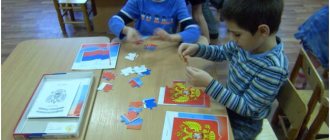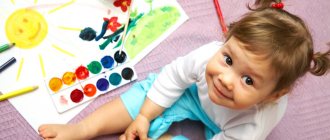Fitball gymnastics in kindergarten
- January 26, 2013
Competition “My Pedagogical Initiative - 2012”
Nomination “Methodological work in preschool educational institutions”
Experience working with fitballs in the educational activities of preschool educational institutions. Peculiarities of learning and development of children with hearing loss in physical education and health activities.
Fitballs are considered non-traditional equipment in kindergarten, but at the same time they have a good therapeutic effect.
Fitballs strengthen the muscles of the back and abdominals, create a good muscle corset, develop coordination and a sense of balance, but most importantly, they form the skill of correct posture, which is difficult and time-consuming to develop under normal conditions. In addition, the cardiovascular and respiratory systems are trained, endurance develops, and the mobility and flexibility of the spine increases.
Exercises on the ball help develop strength, energize, and increase blood circulation and metabolism.
Since 2009, our kindergarten has been attended by children with hearing impairment (hard of hearing and after cochlear implantation). For preschoolers with hearing loss, physical education plays an even greater role than for their normally developing peers, because they are characterized by a variety of changes in the motor sphere. The most characteristic and pronounced include:
- insufficiently precise coordination and uncertainty in movements,
- difficulty maintaining statistical and dynamic equilibrium,
- relatively low level of development of orientation in space.
Such features in the development of children are associated with disruption of the vestibular apparatus. Therefore, now in classes, special emphasis is placed on the development of the above physical qualities.
Therefore, in physical education classes and other forms of educational activities, it was decided to use fitballs - balls.
At the moment, the use of fitballs is especially relevant, because they have a number of advantages, among other equipment. Such balls, as a means of health-improving and corrective work, were chosen due to their specific effect on the musculoskeletal, ligamentous-muscular system. An elastic, unstable environment is necessary for the formation of the vestibular apparatus, the development of the mechanism of balance and rhythm of movements.
My experience of working with fitballs allows me to recommend them as a highly effective and affordable tool in the physical development of a preschooler.
Such balls significantly expand the possibilities of physical education and health work, and help to increase the effectiveness of psychological, pedagogical, correctional and rehabilitation support for the child.
Fitball - gymnastics in kindergarten
There are many different balls: with handles, “horns”, and oval, and with pimples. They not only have different shapes and sizes, but also bright colors. Children enjoy working out on such simulators.
Where can you use fitball balls?
Using fitball balls in classes combines the work of the motor, vestibular, visual and tactile analyzers, which are activated when performing exercises on the ball, thereby enhancing the effect of the classes.
Games with fitballs can be used not only in physical education classes, but also in everyday work:
- in classes as a physical education lesson;
- on a walk;
- in children’s independent games, relay races;
- in entertainment, holidays and leisure;
- in individual work;
- using breathing exercises,
- rhythm blocks with music;
- for mastering air traffic control and outdoor switchgear.
The use of fitballs in joint work with parents is very effective. Child-parent relationships are especially well normalized. Children feel the joy of joint physical activity, as well as the support of their parent.
Fitball – balls add variety to leisure time, holidays and entertainment. Techniques using chants and musical accompaniment help coordinate movements, breathing and speech, since the individual internal rhythm of such children is often slow. You can also combine breathing exercises with exercises on balls, using their vibration properties.
The use of fitballs increases children’s emotional involvement in the activity.
Increases the effectiveness of health-improving tasks and the absorption of material.
Also, fitballs allow you to diversify outdoor and relay games; they give children joy and health.
Stages of training
Ball training takes place in several stages.
But when starting to work on balls, you should know that the ball must correspond to the age of the child - 45 cm - 4-5 years; 50cm-5-6 years; 55cm-6-7 years. When landing on the ball, the angle between the thigh and shin should be 90*.
Oval balls are convenient because the support becomes more stable; such balls are suitable for children at the first stage of learning and for those who are afraid of falling.
And you can start using fitballs from an early age.
A ball for young children is a means of communication. It helps to quickly find contact with the child. Forces the child to be in motion all the time, thereby constantly arousing new interest. (Roll, toss, clap, jump on the ball, ride on it, lie down).
The purpose of stage 1 is:
- mastering the ball as equipment. Here you can use exercises such as any rolling, hitting the ball, patting, throwing in pairs, in a circle.
- learning how to sit correctly on the ball.
The second stage is the most labor-intensive:
Stage 2 goal:
- teach children the basic principles. There are about 7-8 such positions on the ball.
- training of major muscle groups, including respiratory ones.
Stage 3
(depends on the level of development of Stage 2 ).
The purpose of this stage is:
- teach basic dynamic movements with the ball.
Children perform exercises in groups, from any starting position, jumping on a ball in place and in motion, in free activity.
Exercises with fitballs can be carried out as part of the lesson, using them only in the main part.
You can also structure the lesson so that the balls are used throughout the entire lesson.
Therefore, to achieve a therapeutic and preventive effect, complexes with fitballs are included in the educational process regularly in courses 3-4 times a year, for 1-1.5 months. This amounts to 10-12 lessons per course.
Of course, all activities for preschoolers are structured in a playful way, since play is the leading activity of a preschooler.
What problems are solved when using fitball gymnastics?
Classes in the senior and preparatory groups, after mastering the three stages, can be carried out using balls throughout the entire lesson. In structure, it resembles a classic physical education class with a strict three-part form, where there is:
Introductory part
- development of all types of attention,
- perception and memory,
- orientation in space based on basic movements.
Main part
- mastering general developmental exercises,
- exercises on fitballs,
- main types of movements.
Final part
- outdoor game,
- relaxation.
Let's look at each part of the lesson separately. What motor tasks and exercises can be included in this part?
Introductory part 3-5 min
- Formation, different types of walking, hand movements with the ball
- Running while dribbling the ball, rolling
- Jumping with the ball between the legs, with advancement, sitting on the ball.
- Walking with breathing restoration and various types of changes in movement.
Main part 15-20 min
- strengthening the muscle corset around the spine
- increasing mobility and flexibility of the spine
- cardiovascular training
- improving the drainage function of the lungs and strengthening the respiratory muscles.
Final part 3-5 min
- restoration of the cardiovascular and respiratory systems
- includes quiet play and relaxation exercises.
List of used literature:
- 1. Correctional “Program for the education and training of hearing-impaired preschool children.” / N. D. Shmatko, L. A. Golovchits and others - Moscow: “Enlightenment”, 1991.
- Fun physical education for children and their parents. Entertainment activities, holidays, hikes. / Kazina O.B. – Yaroslavl: “Development Academy: Academy Holding”, 2005. – 140 p.
- Improvement of children's health in a kindergarten. /L.V. Kochetkova. – M: Sphere shopping center, 2005. – 112 p.
- Health-forming physical development: Developmental motor programs for children 5 – 6 years old: /I.K. Shilkova - M.: “Humanite. ed. VLADOS center", 2001. – 336 p.
- Health training system “Isoton”, “Sports technologies”
Presentation
Author: Svetlana Nikolaevna Stepanova, physical education teacher of the highest qualification category, State Budgetary Educational Institution Secondary School No. 1747, preschool department “Olenyonok”, Moscow. Work experience 13 years. Awarded a Certificate of Honor from the Ministry of Education and Science of the Russian Federation.
Methods of working with correction balls or fitballs
Different preschool educational institutions have different approaches to organizing fitball aerobics. In some kindergartens, this method is used as independent training 1-2 times a week. In others - as an element of dancing, free creative activity of children.
The training program with correction balls includes 4 areas:
- Fitball gymnastics is a general developmental technology that includes dynamic exercises and stretching tasks.
- Fitball rhythmics includes dance rhythmic elements.
- Fitball-athletics involves strength training, due to which different muscle groups develop.
- The fitball game consists of game tasks, competitions, and relay races.
Rhythm and athletics are mainly designed for children of primary school age. In kindergartens, only individual elements are usually used, and the main emphasis is on gymnastic and play forms.
Fitball-gymnastics solves health-improving, educational and educational problems
Training using a gymnastic ball not only helps strengthen the body and develop the musculoskeletal system. Thanks to game sets of exercises, you can develop the creative direction of a child’s personality. The classes use fairy tales, entertaining stories from the lives of favorite heroes, cartoons and book characters. This helps develop imagination and imaginative thinking.
Background music teaches children to move to the beat of the music, creates the right mood, and increases physical and emotional activity.
If the training is based on a fairy tale with an instructive plot, then it has an additional educational function, allowing children to understand how to act in certain situations from the standpoint of morality and ethics.
Preschoolers and schoolchildren
Fitball for preschoolers and schoolchildren is no less important. This simplest tool will help distract children from computers and gadgets, on which modern children spend a lot of time. Here are some exercises you can offer children:
- lifting the ball over your head;
- throwing a ball to coordinate hand movements;
- squats with a ball;
- throwing the ball to the parent;
- rolls on a fitball on the back;
- maintaining balance while sitting on the ball;
- bridge on the ball.
When choosing a fitball for preschoolers and schoolchildren, it is better to focus on large balls - this makes it more convenient for children to practice on them. It’s good if the fitball has a handle - it’s very convenient for many exercises, and it’s easier to carry a large ball. When buying a fitball, be guided by the child’s weight, but current manufacturers make excellent, strong balls that have been tested in production. This type of fitness equipment will not harm your health and will help diversify your child’s leisure time.
The benefits of fitball
A fitball is not only a colorful toy for a child; first of all, it is a tool for actively engaging in feasible physical exercises. Thanks to the fitball, the following health benefits appear:
- intestinal function is normalized, the child suffers less from colic, which is especially important from the third month, when babies experience pain in the abdomen due to swallowing air during feeding;
- muscle hypertonicity is eliminated, especially if the child was born with neurological disorders and hypertonicity is diagnosed;
- the nervous system is stabilized, in the process of exercises a close connection with parents is established, because the baby can do exercises not only with mom, but also with dad;
- blood circulation is stimulated;
- breathing improves;
- coordination of movements develops;
- flexibility increases, the muscle corset is strengthened, especially the back and lower back;
- exercises are an excellent means of preventing diseases of the musculoskeletal system;
- The body's endurance increases and the immune system is strengthened.
Fitball is recommended for children who have hip dysplasia, increased nervous excitability and hypertension, excess weight, large gains in the first year of life, constipation, colic.
To make the exercises as effective and safe as possible, choose the right ball. The fitball should be at least 75 cm in diameter, but for infants it can be smaller - it can be used on the sofa or in the crib.




